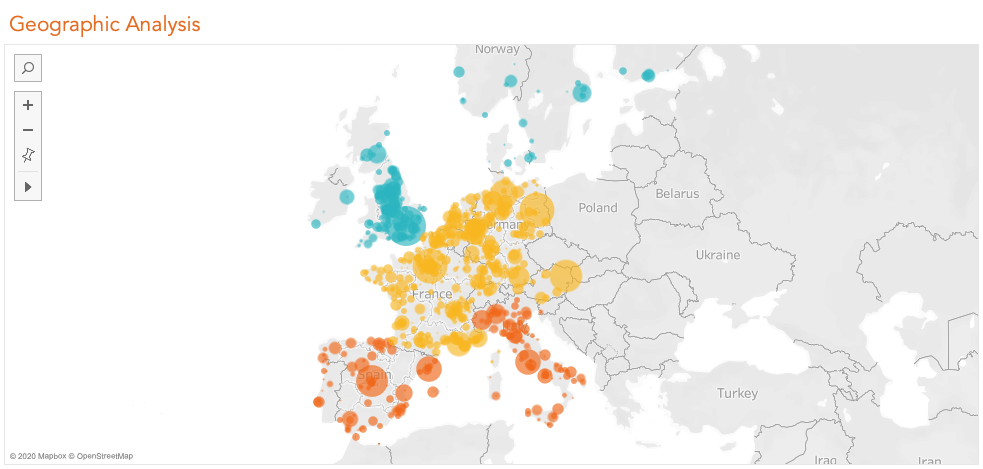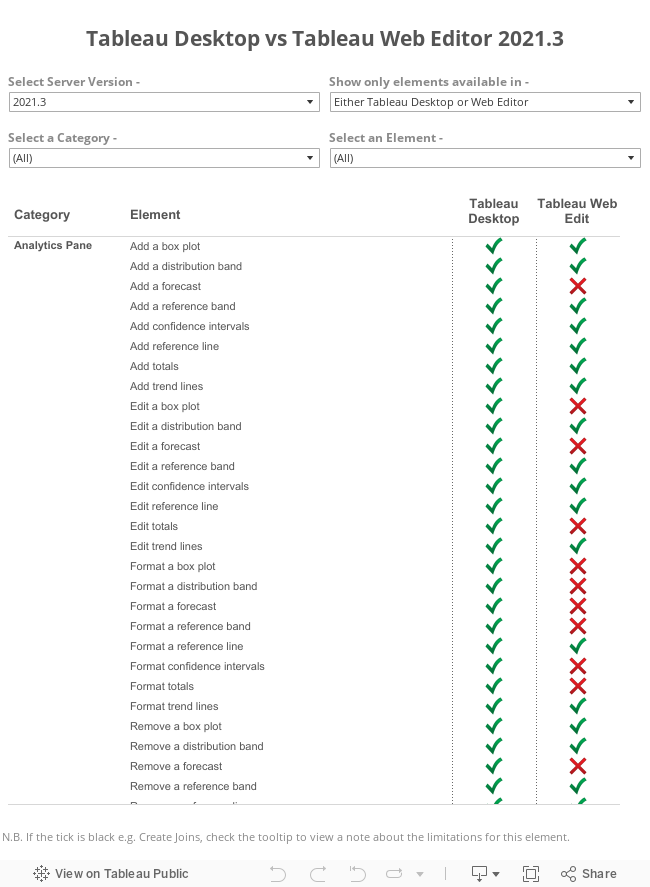When virtual desktop support is enabled, Tableau Desktop or Tableau Prep Builder periodically contacts a Tableau-hosted authorization-to-run (ATR) service to verify that.
- Tableau Desktop Resolution Option 1: Use Two Pie Charts Step 1: Create a pie chart. In Tableau Desktop, connect to Superstore sample data. Under Marks, select the Pie mark type. Drag Customer Segment to Color. Drag Sales to Size. Click Label, and then select Show mark labels. Resize the pie chart as desired.
- Tableau Desktop Tableau Server Answer. Go to Downloads and Release Notes. Select your desired product and version. Click the Download button. Click the link for your operating system to download Tableau Desktop or Server to your computer. Follow the prompts during installation. Additional Information.
- Tableau Tutorial
- Tableau Data Sources
- Tableau Worksheets
- Tableau Calculations
- Tableau Sort & Filters
- Tableau Charts
- Tableau Advanced
- Tableau Useful Resources
- Selected Reading

Tableau is a Business Intelligence tool for visually analyzing the data. Users can create and distribute an interactive and shareable dashboard, which depict the trends, variations, and density of the data in the form of graphs and charts. Tableau can connect to files, relational and Big Data sources to acquire and process data. The software allows data blending and real-time collaboration, which makes it very unique. It is used by businesses, academic researchers, and many government organizations for visual data analysis. It is also positioned as a leader Business Intelligence and Analytics Platform in Gartner Magic Quadrant.
This tutorial is designed for all those readers who want to create, read, write, and modify Business Intelligence Reports using Tableau. In addition, it will also be quite useful for those readers who would like to become a Data Analyst or a Data Scientist.
Before proceeding with this tutorial, you should have a basic understanding of Computer Programming terminologies and Data analysis. You should also have some knowledge on various types of graphs and charts. Familiarity with SQL will be an added advantage.
Among the multiple data visualization products in the market, there is one solution that certainly stands out — Tableau Software. An application for translating raw data into valuable insights, it has provided an unparalleled user experience for 16+ years. While there are pros and cons of Tableau software, Gartner’s 2019 Magic Quadrant for Business Intelligence and Analytics Platforms rates it as a leader for seven consecutive years.
Why Opt for Visualization
Why do companies tend to step over the bounds of traditional written, audio and video data sources and go for data visualizing tools? It would seem that the modern human is far more advanced as to be affected by a colorful eye-catching image. And yet, psychological research shows that 90% of all the information that people perceive comes from their sense of sight. And the simpler the way the information is put, the higher the chances that it is processed.
Apparently, transforming analytical information into optical form facilitates its digestion and understanding and allows to uncover valuable data. This may work in companies’ favor if they leverage such a peculiarity correctly, as it allows enhancing business processes and improving employees’ performance. So, an increasing number of companies turned to data visual depiction, and big market players have developed their solutions for stats visualization, such as:
- Microsoft
- Qlik
- SAP
- IBM
- Salesforce
- Oracle
- Others
What Is Tableau Software?
Not only does the Gartner rate Tableau analytics platform highly, but there are numerous user testimonials that assert that its visuals are the number one in the market and consider this software the enterprise standard. What does Tableau visualization software do and why is it so specific that many businesses have come to incorporate it into their daily operations?
A powerful business intelligence tool for analytics visualizing, Tableau casts the results in numerous vivid forms to get better insight.

Healthcare, insurance, manufacturing, education, marketing, wholesale and retail, and other business domains have been already making an extensive use of the insightful data visualization performed by Tableau.
The solution’s functionality is not limited by the graphic information representation; there is also a heap of work under the surface. Indeed, the application makes requests to the cloud and relational databases, spreadsheets and OLAP cubes for the required statistical data, and then parses, categorizes and correlates it to generate a comprehensive analytical report. Tableau has both desktop and online versions, which enables access to software data in the cloud or on premises.
If your company seeks to improve analytics and get the most out of what data rendition offers, you must have your sights set on Tableau data visualization software. However, before being taken with its remarkable visualizing capabilities, learn the limitations of Tableau as they pertain to your business — check out our Tableau reviews.
The Pros of Tableau Software

Although the ultimate quality visualization of interactive data overshadows all other Tableau advantages, the list of the benefits that the tool brings to businesses is quite long.
1. Remarkable Visualization Capabilities

Of course, unparalleled capabilities of visualizing information is on top the list of Tableau software benefits. The application’s data visualizing quality is superior to what Tableau software competitors offer. Even the products of traditional business intelligence vendors, such as Oracle Data Visualization or IBM’s products for data rendition, cannot compete with the illustration and design quality that Tableau provides.
It converts unstructured statistical information into comprehensive logical results, which are fully functional, interactive and appealing dashboards. They are available in several types of graphics and are easy to use in business affairs.

2. Ease of Use
The tool’s intuitive manner of creating graphics and a user-friendly interface allow non-dev users to utilize the basic app’s functionality to the fullest. Users arrange raw data into catchy diagrams in a drag-and-drop way, which facilitates information analyzing and eliminates the need for the help of an IT department for pattern building.
Lay users can enjoy the capabilities that Tableau offers for stats parsing, such as dashboard development, etc., without in-depth training. However, to get into the solution’s capabilities, deeper knowledge is a must. Also, the close involvement of IT specialists is a necessity if a company seeks to expand the solution’s functionality.
| Read also: Customer Experience vs. E-Commerce: Comparison and Striking Examples |
3. High Performance
Apart from its high visualization functionality, users rate its overall performance as robust and reliable. The tool also operates fast even on big data, which makes its powerful performance an important point in the list of the advantages of Tableau.
4. Multiple Data Source Connections
The software supports establishing connections with many data sources, such as HADOOP, SAP and DB Technologies, which improves data analytics quality and enables the creating of a unified, informative dashboard. Such a dashboard grants access to the required information for any user.
Download Now | Tableau Public
5. Thriving Community and Forum
The number of Tableau fans who invest their expertise and skills in the community increases steadily. Business users can beef up their knowledge on data parsing and reporting and get many useful insights in this community. Also, forum visitors are ready to help settle any user issues and to share their experience.
Tableau Download
6. Mobile-Friendliness
And the last one in our list of core Tableau benefits, there is an efficient mobile app available for IOS and Android. It adds mobility to Tableau users and allows them to keep statistics at their fingertips, as well as it supports full functionality that a Desktop and Online versions have.
| Read also: A Mobile App: Why Your Business Needs It |
The Cons of Tableau Software
Despite its superior visualizing and designing capabilities and its other advantages, Tableau’s limitations are quite numerous, which is why they should be taken into serious consideration.
1. High Cost
Tableau is not the most expensive visualization software, especially compared to such business intelligence giants as Oracle’s and IBM’s solutions. All the same, the license is quite costly for most small to medium companies, which makes it one of the considerable Tableau’s disadvantages. Also, the software requires proper deployment, implementation, maintenance and staff training that come at a sizeable price. Therefore, its high cost makes Tableau the choice of primarily large businesses.
2. Inflexible Pricing
Tableau’s sales team is not flexible enough to provide a case-by-case approach for their customers. Ignoring the fact that each company has its own unique requirements to the visualization tool package, the Tableau sales model requires clients to purchase the extended license from the start. As a result, a lot of companies that use Tableau arrive at the conclusion that they don’t need all their licensed features. They would prefer buying a set of required ones and scale them if necessary.
3. Poor After-Sales Support
More Videos For Tableau Desktop »
On multiple message boards, users complain that Tableau software lacks proper after-sales maintenance. If a customer has a software performance problem, the support team doesn’t settle the matter by investigating the problem’s root and eliminating it. The best they do is to advise purchasing a feature, which will compensate for their software’s shortcoming.
4. Security Issues
Since visualizing solutions manipulate some confidential data, the vendors draw special attention to security enhancement. Despite Tableau ’s deep concern for information safety, it fails to provide centralized value='0' name='>
Cached
- 7 votes
- 1 vote
- 1 vote
- 0 votes
- 1 vote
